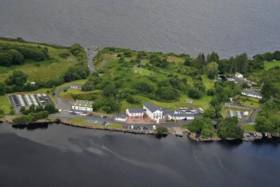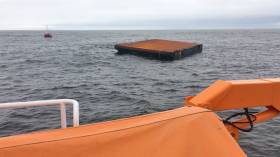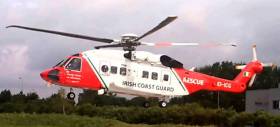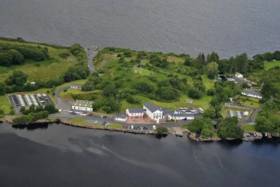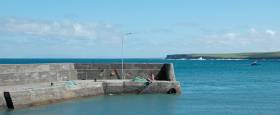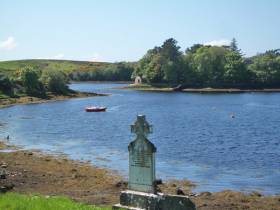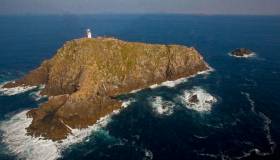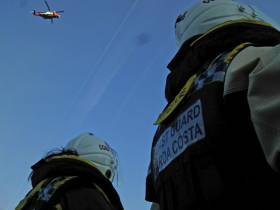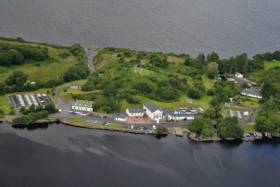Displaying items by tag: Mayo
Marine Institute’s Newport Base Open To The Public This Sunday
The Marine Institute’s research facility in Newport, Co Mayo will open its doors to primary school children this week and to the general public for an open day this Sunday 14 April from 11am to 4pm.
Primary pupils from Newport, Kilmeena, Carrowaholly, Glenhest, Knockroosky and Snugboro schools in Co Mayo will visit the Newport Catchment Facility on today and tomorrow (Wednesday 10 and Thursday 11 April) to speak with marine scientists and view the freshwater hatchery and fish rearing facilities on site.
A number of PhD candidates will also be available to talk to students about their subject choices and potential careers in the marine sector.
Beavers and cubs from the Westport and Ballyhaunis Scout groups will have an opportunity to tour the facility this Saturday 13 April.
And the open day at Newport Catchment Facility thus Sunday offers an opportunity for visitors to view the facilities in the Burrishoole Valley and learn more about the research taking place at the site.
A range of cutting-edge research is undertaken at the Newport Catchment Facility including genetics work across several species of salmon, sea bass, pollock and bluefin tuna, as well as research on catchment ecosystems events, climate change, oceanography and aquaculture.
Marine Institute chief executive Dr Peter Heffernan said: “We welcome visitors to our Newport facility to see the work that is being undertaken by scientists and postdoctoral students that not only contributes to national research, but also has international relevance.
“Our open day is also an opportunity to engage the public and increase awareness of the value and opportunities of our marine resource, a goal of Ireland’s marine plan Harnessing Our Ocean Wealth.”
New Angling Bye-Laws For Corrib Catchment In Galway & Mayo
#Angling - Seán Kyne, Minister of State with responsibility for the inland fisheries sector, has signed off three new angling bye-laws which affect the Corrib catchment in Galway and Mayo.
The bye-laws, which have been requested by local angling clubs, concern the Abbert and Grange Rivers, the Clare River and the Cong River and Canal, and reflect the support of the clubs for the conservation imperative and the sustainable management of the local fisheries resource.
The Abbert and Grange Rivers (Annual Close Season) Bye-Law extends the closed season for all angling on the Abbert and Grange Rivers by two months to cover the period from the 1st of September until the 31st of March annually.
This bye-law is being introduced at the request of the angling clubs on the Clare system and will act as a vital conservation measure.
Both rivers make a significant contribution to wild brown trout stocks in the Clare River system and Lough Corrib. The new bye-law will afford greater protection to spawning salmonids in these two very important tributaries of the Clare River.
The Western Fisheries Region River Clare (Revocation) Bye-Law permits all legal angling methods on the Clare River from Daly’s Bridge in the townland of Corrandrum to a point 300 metres upstream of the footbridge at Anbally in the townlands of Anbally and Turloughmartin, Co Galway.
This section of river was previously restricted to fly fishing only. However, this new bye-law will bring this short section of the river into line with the rest of the Clare River. This bye-law was introduced at the request of the local angling club.
The Upper and Lower Limits of Cong River and Cong Canal Bye-Law clearly defines the upstream boundary between Lough Mask and the Cong Canal and the downstream boundary between the Cong River and Lough Corrib.
The purpose of the bye-law is to enable the effective enforcement of legislation governing the open angling seasons for trout and salmon on the Cong Canal/River as these differ from the open seasons for these species on Loughs Corrib and Mask.
This bye-law will also remove any difficulty in identifying the correct angling season at the extremities of the Cong River/Canal and will afford greater protection to highly prized ferox trout which are known to spawn in the Cong River/Canal.
“We welcome the introduction of these bye-laws in Galway and Mayo which will help us to enforce relevant legislation and enhance the resource in the long term,” said Inland Fisheries Ireland chief executive Dr Ciaran Byrne.
“The introductions of these bye-laws follow public consultations whereby stakeholders were invited to input their views and insights into the proposed new regulations. Inland Fisheries Ireland’s fisheries officers will now protect these rivers in line with the new laws in place.”
Anglers are requested to familiarise themselves with the details of the new bye-laws, which can be found on the website of the Department of Communications, Climate Action & Environment.
#RNLI - Ballyglass RNLI’s lifeboat crew had an unusual callout on Monday evening (14 May) when they were launched to recover a runaway barge that had drifted to the Mayo coast across the Atlantic from Canada more than 3,000km away.
The large floating barge had broken from its moorings in Labrador in north-east Canada last November, and after six months at sea was spotted and reported by a passing fishing vessel earlier on Monday.
Ballyglass RNLI received the call to launch last night at 7.20pm. On arriving on scene, the lifeboat crew found a steel barge measuring 26 metres by 16 metres, which was unsecured and floating.
The lifeboat crew established a tow and brought the barge back to Ballyglass Harbour.
However, with no room to berth such a large barge safely, it was put on the lifeboat mooring before a more permanent solution could be found. The crew were not stood down until 2am this morning.
All in all, it took the lifeboat crew seven hours to secure the barge and and bring it safely to Ballyglass.
Commenting on the shout, Ballyglass RNLI lifeboat operations manager Padraic Sheeran said: “We were not expecting this type of callout at all. You do hear of vessels and craft breaking free of moorings but it’s unusual to have one drift thousands of kilometres and have to be rescued by lifeboat.
“On a serious note though, it represented a major navigational danger to any vessel that it collided with and it was a relief to have it safely recovered.”
The callout will remind Afloat.ie readers of the houseboat that drifted from Newfoundland to the Mayo coast in November 2016.
Man Dies After Fishing Boat Capsize Off Mayo
The Irish Mirror reports that a man has died after a fishing boat capsized off the Mayo coast yesterday afternoon (Tuesday 10 April).
It’s understood that the deceased was a man in his 50s from North Mayo. He was one of three men recovered from a life raft some 16 miles off Eagle Island after their vessel sank.
Ballyglass RNLI and the Irish Coast Guard’s Sligo-based helicopter Rescue 118 were immediately tasked to search the area when a Mayday broadcast was picked up shortly after 12.30pm.
Rescue 118 spotted flares less than an hour later and proceeded to airlift the casualties for transfer to Sligo University Hospital.
The Marine Institute’s Research Facility in Furnace, Newport, Co Mayo will open its doors on Saturday 14 April from 11am to 4pm.
The open day is for all, and visitors will have the opportunity to view the facility for studying migratory fish, located in the Burrishoole Valley.
Visitors will be able to learn more about the history of the facility and the marine science projects taking place at the site.
They will also have the opportunity to speak with researchers, scientists and staff at the Newport facility. A number of PhD candidates will be available to talk to students about their subject choices and potential careers in the marine sector.
Visitors can look through microscopes to see freshwater invertebrates, view fish species up-close in the aquarium displays and learn how to read a salmon scale.
There’s also the chance to visit the manual climate station and see the instruments used to collect daily data for Met Éireann.
The Marine Institute describes its facility in Newport as “a unique research centre” where a range of research is undertaken, including genetics work across several species of salmon, sea bass, pollock and bluefin tuna, as well as studies on catchment ecosystems events, climate change, oceanography and aquaculture.
The facility, which has been in operation since 1955, includes laboratories, a freshwater hatchery, fish rearing facilities, fish census trapping stations, a salmonid angling fishery and a monitored freshwater lake and river catchment.
Connemara & Mayo Drowning Victims Remembered 90 Years On
#ClegganBay - The Irish Times writes on Saturday’s (28 October) memorial service for lives lost in the Cleggan Bay Disaster 90 years ago.
Forty-five men, many of them from Connemara, died after a sudden and severe storm hit a small fleet fishing for herring off the Mayo coast in October 1927.
Descendants of some of those whose lives were taken in the tragedy gathered at a memorial at Lacken pier on Saturday which also paid tribute to diver Michael Heffernan, who was lost in a cave rescue in the region in October 1997.
Masses were also held in Claddaghduff and on Inishbofin, which was home to many of those lost in the incident.
The commemoration had an additional resonance with the loss of five Irish Coast Guard personnel in recent months — the crew of Rescue 116 and volunteer Caitriona Lucas, who was posthumously awarded the State’s highest honour earlier this month.
The Irish Times has much more on the story HERE.
#Angling - An angling bye-law focusing on salmon and sea trout has come into effect for Burrishoole, Co Mayo.
Sean Kyne, Minister of State with responsibility for Inland Fisheries, introduced the Conservation of Salmon and Sea Trout Shramore (Burrishoole)(Catch and Release) Bye Law No 951 into operation on Tuesday 13 June.
The new bye-law provides for catch and release angling for salmon and sea trout over 40cm in length in the Shramore (Burrishoole) system, and applies to Lough Furnace and the Seven Arch Bridge on the L5435 (old Newport Road).
Operative from Wednesday 14 June till Saturday 30 September, the bye-law and provides for the use of single barbless hooks while prohibiting the use of worms as bait in angling for salmon and sea trout.
‘Catch and release’ angling refers to the method of carefully handling any fish caught and immediately returning the fish alive to the water. This form of angling has a significant positive impact on the survival rate of released fish.
In addition, salmon and sea trout caught by fly fishing using single barbless hooks have a greater chance of survival than fish caught on barbed hooks. Barbless hooks do less damage, are easier to remove and reduce handling time which can be an important factor influencing survival.
Salmon and sea trout are some of Ireland’s main wild fish species attracting domestic and overseas anglers alike. Angling contributes €836 million to the Irish economy annually and supports upwards of 11,000 jobs which are often in rural communities.
Dr Ciaran Byrne, chief executive of Inland Fisheries Ireland, said: “Our salmon and sea trout stocks are extremely valuable. These new measures at Shramore, Burrishoole, will allow us to introduce a number of important methods which will help us protect these populations into the future.”
Anglers are requested to familiarise themselves the details of the new bye-law, available as a PDF to read or download HERE.
#Rescue116 - The Irish Lights vessel Granuaile is in Galway preparing to join the search for the missing crew of Rescue 116, according to Galway Bay FM.
The multifunctional vessel, built to operate in difficult sea conditions, is being stocked with additional equipment ahead of a major search of the crash site off Blacksod in Co Mayo scheduled for tomorrow (Sunday 19 March) with the forecast of improved weather conditions.
TheJournal.ie reports that what’s believed to be wreckage from the Sikorsky S92 helicopter has been found on the island of Black Rock, west of Blacksod, but there are no signs of a crash having occurred at that site.
The coastguard helicopter’s black box was also detected on Wednesday (15 March) near the island, but divers have been prevented from reaching its location due to the poor weather and sea state.
Three crew – chief pilot Mark Duffy and winch men Paul Ormsby and Ciarán Smith — remain missing after the incident in the early hours of Tuesday (14 March) as the Dublin-based Irish Coast Guard helicopter provided top cover for a medevac.
The funeral of Capt Dara Fitzpatrick, who was taken from the scene in the first hours of the search and rescue effort, takes place this morning (Saturday 18 March).
Meanwhile, it emerged on Thursday (16 March) that Rescue 116 was tasked to the scene on Tuesday after the Irish Air Corps was unable to provide assistance due to reduced capacity, according to The Irish Times.
#Rescue116 - One person has been taken from the scene in the search for an Irish Coast Guard helicopter and crew that went missing off Mayo in the early hours of this morning, according to the Galway Advertiser.
Update 2.55pm: The Irish Times confirms that the casualty recovered this morning, named as Captain Dara Fitzpatrick, was pronounced dead in hospital. Capt Fitzpatrick was one of the Irish Coast Guard's most senior helicopter pilots, and in 2013 flew Ireland's first missions with an all-female flight crew.
As previously reported on Afloat.ie, a major search operation was launched some six miles west of Blacksod at 1am this morning (Tuesday 14 March) after contact was lost with the Dublin-based Rescue 116 as it provided top cover during a rescue mission.
Coastguard officials conformed that four crew were on board the Sikorsky S92 long-range SAR aircraft at the time.
The individual recovered from the scene within the last 30 minutes is reportedly in critical condition.
Taoiseach Announces €6M Investment & 20 New Jobs At Co Mayo Marine Research Facility
#MarineScience - Taoiseach Enda Kenny today (Saturday 28 January) announced the creation of 20 new jobs and a €6 million investment in the Marine Institute's facility in Newport, Co Mayo.
The 20 new positions will be based at Newport research facility where they will be engaged in a number of projects funded from a secured pot of €6 million in research grants from a number of agencies including the Science Foundation Ireland, Interreg, EU H2020/European Research Council, European Maritime and Fisheries Fund (EMFF) and the British Research Council.
Speaking in Furnace, near Newport, the Taoiseach — who is also TD for Mayo — said the move “is very timely following the launch of Realising our Rural Potential – the Action Plan for Rural Development earlier this week.
“The Newport facility is a real example of innovation taking place in a rural community and creates exciting opportunities both now and in the years ahead.
“Scientists at doctoral and post-doctoral level working at the facility are involved in conducting research with not only national implications, but also international relevance. In other words, it firmly brings what is a rural area into a national and international context.”
The Taoiseach added: “This is a relatively unique research facility in operation since 1955 and I am delighted to see the continued excellent quality research that is taking place following €6 million in funding from research grants.
“I also wish to thank the Marine Institute and their educational partners for their efforts in building a strong international reputation for marine research and innovation."
The Marine Institute says a range of cutting edge research is carried out at its Newport facility including genetics work across several species of salmon, sea bass and pollock, research on the catchment, and climate change.
The facility is attracting multiple Irish Higher Education Institutions and international partners including University College Cork, Queens University, University College Dublin, GMIT, Dundalk Institute of Technology, NUI Galway and the University of Glasgow.
In addition, the Marine Institute is working with Mayo County Council to actively develop new initiatives at the facility to further enhance what the Marine Institute can offer and benefit the local area.
Supporting the announcement, Marine Minister Michael Creed said that his department and the fishing industry consider pollock “a very important commercial species for some elements of the Irish fleet. It is good to see a new project on this species being carried out in Newport, using the scientific expertise that is there."
Marine Institute chief executive Dr Peter Heffernan added: "Ireland has been gaining a reputation in Europe, and internationally for its marine research and innovation, and for driving collaboration in this area. We have a strong marine research community supported by growing national research infrastructure.
“This €6 million investment programme will see the Marine Institute expand its research capacity at its Newport facility and the continued investment in marine research will ensure that Ireland stays at the cutting edge of research and innovation."
In his own welcoming statement, Mayo county manager Peter Hynes said: "This is fantastic news for Mayo and the West region and Mayo County Council looks forward to continuing to work with the Marine Institute to further develop this cutting edge research facility here in Newport."


























